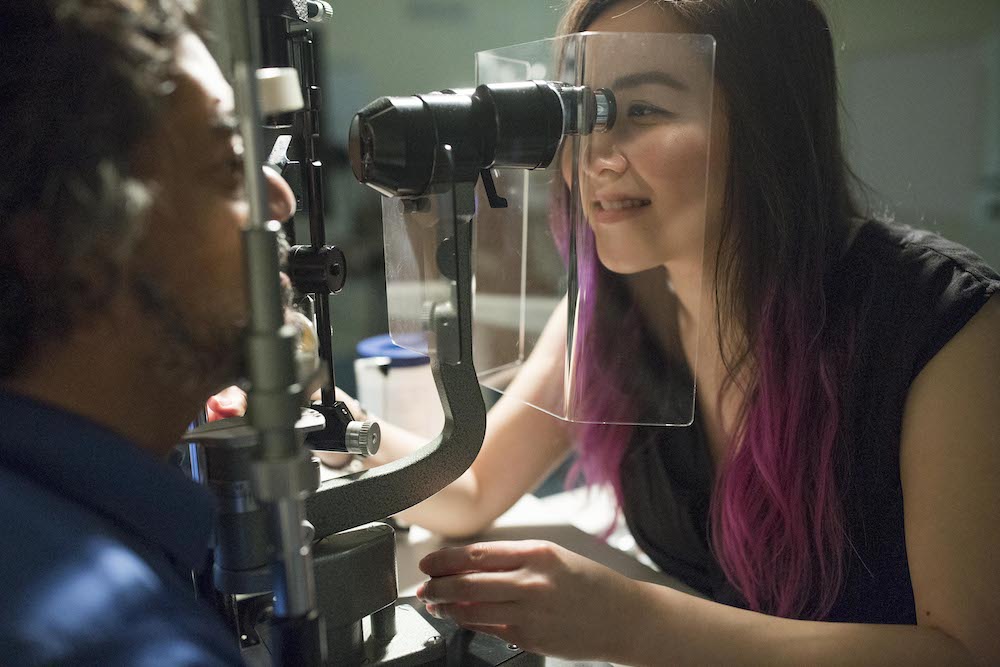This website uses cookies so that we can provide you with the best user experience possible. Cookie information is stored in your browser and performs functions such as recognising you when you return to our website and helping our team to understand which sections of the website you find most interesting and useful.
News
Meet CERA’s next Superstar of STEM
CERA researcher Dr Flora Hui is set to inspire the next generation of STEM experts as part of the Superstars of STEM program.
“When I went to school, I didn’t think I was going to be a scientist or an optometrist – yet here I am,” says CERA’s Dr Flora Hui.
“In my head, scientists were still white and male, so I never saw myself as someone that would go into science and become a researcher.”
While she didn’t set out to study optometry, taking a subject in vision science at university sparked a fascination that would evolve into a successful career.
From here, Dr Hui worked towards her PhD, where her supervisor helped guide her research interest towards glaucoma.
“I’m fortunate to have been inspired by people with a passion for research, like my PhD advisor, Associate Professor Bang Bui and my first boss as a researcher, Professor Jonathan Crowston, who was CERA’s former managing director,” says Dr Hui.
At CERA, Dr Hui moved into clinical research – regularly meeting people living with glaucoma and hearing their individual stories.
At the same time, Dr Hui says there was a more immediate connection to the eye disease that also drove her research.
“When my mum was diagnosed with glaucoma, I realised there’s so much work that needs to be done – and hopefully I could contribute to it.”

Inspiring the next generation
Dr Hui is one of 60 women and non-binary science, technology, engineering and mathematics (STEM) experts to take part in Science and Technology Australia’s Superstars of STEM – a national program designed to encourage women and non-binary people to aspire to careers in the field.
As part of the program, she will be supported to become a public champion of STEM through speaking at schools and in the media.
She follows in the footsteps of fellow CERA researcher Dr Jennifer Fan Gaskin, who was part of the program’s 2021 cohort.
Minister for Industry and Science Hon Ed Husic MP has congratulated the newest Superstars of STEM.
“The need to boost diversity in our science, technology, engineering and mathematics sector is urgent,” he says.
“I just know these talented experts and communicators will play their part inspiring Australia’s young people – from all backgrounds – into science and technology.”
Science and Technology Australia Chief Executive Officer Misha Schubert says the program gives women and non-binary talent in STEM crucial skills and confidence to step into media commentary roles.
“By becoming highly visible role models in the media, these Superstars of STEM are showing our diverse next generations of young people – especially our girls and non-binary kids – that STEM is for them.”
Dr Hui says she was “surprised yet honoured” to be selected for the cohort.
“It’s important that young people in school can learn from people who look like them, so they can see that STEM is a career path they can consider – and is actually a very diverse community.”
This announcement follows a successful residency at the Australian Broadcasting Corporation (ABC) after being named a ‘TOP 5 Science’ early-career researcher.
“Superstars of STEM allows me to not only utilise the skills I gained from the ABC residency but also build on them,” says Dr Hui.
Journey to ground-breaking glaucoma research
Dr Hui says she never used to think her story was interesting: “I was just a kid who grew up in Melbourne that found my way into research.
“Then I realised that, growing up, I never saw anyone teaching science who looked like me.
That’s why Dr Hui is keen to visit schools as part of Superstars of STEM and share her story to inspire the next generation of STEM experts.
Dr Hui has led a number of studies including her investigation into the role of vitamin B3 (nicotinamide) in potentially slowing the progress of glaucoma.
“There’s still a lot of questions to be answered, and the more people we have from different backgrounds, cultures and genders to answer them, the better.”

